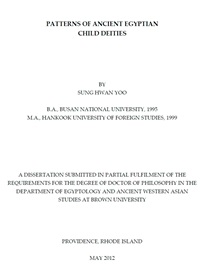| Main » Ad Board » ДРЕВЕН ЕГИПЕТ И АФРИКА » Религия и философия |
| 05.11.2020, 15:59 | |
Божествата-деца заемат специфично място в древноегипетския пантеон. Те са почитани като покровители на раждането, живота, плодородието като растеж на растителността и не на последно място на божественото раждане на фараона като въплътено божество и на династичната приемственост. На тези божества, между които са Хор-детето, Хонсу, Ихи, Нофертум и други, както и на изобрязяването на представите за техния облик е посветено настоящото изследване. Sung Hwan Yoo - Patterns of Ancient Egyptian Child Deities, Providence (RI), Brown University, 2012 - на английски език, от Brown University Repository, формат PDF.Свалянето става с десен бутон (downloading by right button) и Save as... АЛТЕРНАТИВЕН ЛИНК / ALTERNATIVE LINK: Sung Hwan Yoo - Patterns of Ancient Egyptian Child Deities, Providence (RI), Brown University, 2012 - на английски език, от Google Drive, формат PDF. Сваляне с ляв бутон (downloading by left button) от страницата на предоставящия сървър, после през бутона стрелка надолу/after by down arrow button.
| |
| Views: 1037 | Placed till: 05.12.2020 | Rating: 0.0/0 | |

